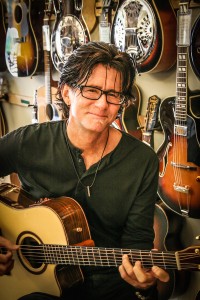by Matthew Von Doran
I once read an article in Guitar Player Magazine about guitarist Larry Carlton where Joni Mitchell was quoted as saying to him, “I like how you edit your playing.” If you listen to Larry’s playing on Joni’s ‘Court & Spark’ album, you’ll notice how sparse & tasteful his parts truly are. He has also used his elegant chops on a few of the classic Steely Dan records, like ’The Royal Scam’ & ‘Aja’, as well as countless others tracks over many decades. He was hired by so many people because they knew he would be able to consistently bring his special touch to their music.
There is an art & science to this kind of playing.
It involves an amalgamation of musicianship skills that must be utilized in a way that supports & enhances the music in just the right way, at just the right moments.
 When you play guitar in a worship band, you will need these same kind of skills. Quite often you are only given a simple chord chart without specific guitar parts or chord voicings written out. It is on you to come up with interesting ideas that contribute to the overall arrangement of the song so that it works on all levels…. meaning, it sounds cool!
When you play guitar in a worship band, you will need these same kind of skills. Quite often you are only given a simple chord chart without specific guitar parts or chord voicings written out. It is on you to come up with interesting ideas that contribute to the overall arrangement of the song so that it works on all levels…. meaning, it sounds cool!
You have many options… strumming chords, arpeggiating chords, creating single note lines or riffs, improvising fills & solos, etc. And then there are the tone & effects considerations.
Define your role in the ensemble
Your musical role in a group is first & foremost defined by the size of the ensemble. Since the prime directive is to blend with others, the less “others” there are in the band, the less likely you will conflict with what someone else is playing. So, a small group will give you a wider field to roam when it comes to creating guitar parts. A larger group would require that you be extra careful with when & how much you play, so err on the side of brevity.
Don’t forget that if you are the only chordal instrument, one of your main jobs is to define the harmony so make sure you are providing chords whose voicings are aurally descriptive of the chord quality (i.e. Major, Minor or Dominant 7th).
If there are two guitarists- one acoustic & one electric- then strumming chords is the acoustic player’s traditional role while the electric player would play parts & solos. But remember, you can be effective in taking the music to another place by using non-traditional approaches to arranging. Try switching roles & give the acoustic the prominent part while the electric takes a back seat. You could have the song start with a muted arpeggio part on the acoustic while the electric creeps in with sparse volumes swells.
Listen
It’s often too easy to get caught up in what you are playing & not really notice what is going on around you, especially if you are reading charts.
A huge part of being a professional musician is developing the ability to pay attention to everything that’s happening in the music of the moment, all the while you are focused on your own playing. Remember to remember to keep scanning the sonic landscape around you & respond appropriately.
One way to develop your peripheral hearing is to take to a recording of a song & listen multiples times, each time focusing solely on only one instrument for the entire length of the recording. You can even focus on just the kick drum or just the keyboardist’s left hand. Do this with one song a day and your ears will become like laser-guided radar dishes that enable you to zoom in on any part of any instrument in the ensemble.
Be aware of the spectrum
As a musician,think in terms of spectrums. The spectrums are comprised of anything musical: dynamics, rhythmic activity, energy, tone, harmony, etc. And what do you do with these spectrums I speak of? Explore the contrasts!
- dynamics = soft to loud
- rhythmic activity = simple to complex, or low activity to high activity
- range = high to low
- energy = low energy to high energy
- tone = bright to dark
- harmony = consonant to dissonant
Can you think of any more?
Always be asking yourself, what kind of energy, tone, volume, et al, does the song call for? All of these things are tied together into a 3D picture of a sonic painting where everyone in the band has a brush. You get to figure out what colors to add… or leave out. Be cognizant that these spectrums ebb & flow along with the song arrangement.
The interplay between each instrument is crucial. Whole notes might not seem super cool, but they could provide the perfect balance to the band if they’re playing really busy. If the verse has lots going on, sometimes adding a simple part made up of just 2 notes every four bars will be the icing on the cake. Or maybe just the sprinkles on the icing on the cake (I like that analogy better).
Think of these things as you work to develop your musicianship skills in your personal practice sessions.
Theory is good!
If there was ever a case for knowing music theory at a fluent level, it is here where you need these skills to create interesting & musical guitar parts in the moment.
It’s cool if you have a good set of ears & you can function as a musician at a high level without much theory knowledge. But playing by ear can sometimes be a flawed strategy in that you must actually play the notes in order to hear if they work or not. In a rehearsal situation, it is not prudent to be playing hunt & peck, or hit & miss, along with the band.
So it is crucial to be able to scope out a chart & know what your options are without having to make any noise. By that I mean knowing your music theory fluently so that you can see a chord symbol for an A major triad in the key of E major and know that you can add color to the harmony by adding the note G#, or B, or F#. or D#. And most importantly, knowing what those notes sound like before you try them out.
So we’re talking about possessing a cognitive understanding of scales, chord voicings & arpeggios and where they are on the fretboard. Which, by the way, means that you know the names of the notes on the fretboard 100%. (Do you?)
It’s totally worth the time & effort to build these skills to a functional level! There are many resources to do so online and this knowledge is crucial to the crafting of guitar parts that make sense.
Consistency keeps it consistent
See what I did there? Clever. I was intentionally redundant. And I repeated myself.
Strive for continuity with your guitar parts… if you come up with one or two parts per section, then use those same parts in each of those same sections as they reoccur. If you tend to play a bunch of different ideas throughout the entire arrangement, then the only consistency you’ll create is in your own inconsistency.
When in doubt, lay out
Let us not forget one final option… don’t play.
You heard me… don’t play, for crying out loud!
Well, I don’t mean pack up your gear & leave.
I mean that sometimes the most effective thing you can add to the music is silence.
Study the art of musical phrasing & you’ll see numerous references to the power of space. And we’re not just talking about break-downs after the bridge where it’s just the drums & whispering vocals. Any section of the song can potentially benefit from your absence. It can sometimes be very effective to lay out for a whole section, so that when you do enter, it’s more of impactful.
Did I mention you need to listen?
I did.
But this time I mean listen to recordings of songs that are artfully produced. Studying art always involves studying the masters. Here the specific agenda is to observe, study & emulate examples of awesome guitar parts.
Tons of personal study, along with experience, is what it takes to develop all of these skills. The best thing you can do is to always be evaluating your own musicianship skills & create a practice agenda that focuses on improving any & all of these areas.
You will soon find that you are able to spontaneously create guitar parts that contribute to the overall performance of any song.


